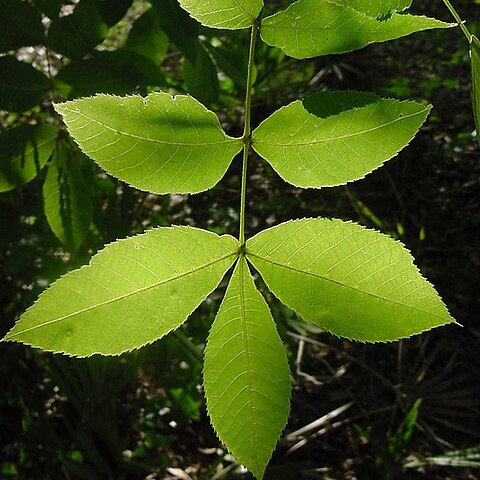Trees , to 25 m; more often shrubs, 3-5 m. Bark gray, smooth or fissured. Twigs reddish brown, slender, glabrous to scaly. Terminal buds golden to rusty brown, ovoid, 3-9 mm, hirsute along margins and densely scaly; bud scales imbricate; axillary buds protected by bracteoles fused into hood. Leaves 2-3 dm; petiole 4-7 cm, with coarse hairs and scales in spring. Leaflets 3-7, lateral petiolules 0-1 mm, terminal petiolules 0-5 mm; blades ovate to elliptic or obovate, not falcate, 4-10 × 2-4 cm, margins often coarsely serrate, apex acuminate; surfaces abaxially with unicellular and 2-8-rayed fasciculate hairs restricted to axils of secondary veins, large peltate scales and small irregular and round peltate scales imparting rusty brown color, adaxially with peltate scales in spring. Staminate catkins pedunculate, to 6 cm, stalks with coarse hairs, rusty brown scales, bracts scaly, sparingly hirsute; anthers hirsute. Fruits bronze to dark brown, obovoid to oblong, not compressed to slightly compressed, not angled, 3-4 × 2-2.5 cm; husks rough, 2-3 mm thick, dehiscing to base, sutures slightly winged; nuts tan, ellipsoid, slightly compressed, not angled, rugulose; shells thick. Seeds sweet. 2 n = 64.
More
A small tree. It grows 6-8 m tall and spreads 3-5 m wide. It has many branches and a spreading crown. The trunk is 20 cm across. The bark is grey and smooth. The twigs are covered with rust coloured hairs. The leaves are compound and 10-20 cm long. The leaves have leaflets along the stalk. There are 5 distinct leaflets and these have fine teeth. The leaflets are 4-10 cm long. They are green above and yellowish-green underneath. The flowers are very small and green. The male flowers are in slender drooping catkins. There are 3 hanging from a stalk. The female flowers are at the tips of the same twigs. The fruit are 2-3 cm long and slightly pear shaped. They narrow to a stalkless base. The thin husk splits into 3 parts. The nut is rounded and 15 mm across. The nuts are edible.


